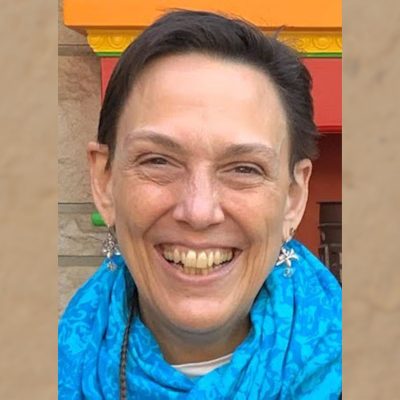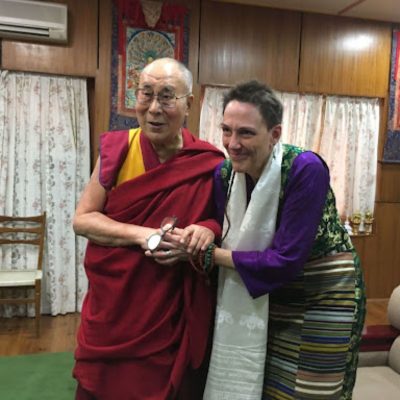Articles
What we’re contemplating, doing, and reading.
Compassion Cultivation Training©: A Light for These Times

The parable of a hummingbird encountering an incredible forest fire captures my attention. This tiny bird flies back and forth between a stream and a raging fire with a drop of water in her beak, releasing it on the fire’s wrath before returning for more. The much larger animals watch with disbelief and try to dissuade her. But she courageously responds, “I am doing the best I can, with the gifts I have.”
I am only one of billions born in a century and in a country (the U.S.) that has enjoyed a certain amount of autonomy and freedom. Only one, some might say. But I respond: still one who can join countless others, doing the best we can.
For thirty-some years my altruistic efforts took the form of service as a Christian minister. I have worked in cross- cultural settings and among diverse religious traditions with Native American people in Chicago and through becoming family for refugees, both there and in Louisville. I helped create an inner city retreat center that brought high school aged young people and neighborhood folks together to forge “radical relationships” — bridging and transforming prejudices and assumptions.
For the past decade, I have served as director of Drepung Gomang Center for Engaging Compassion (DGCEC), a Tibetan Buddhist Dharma center that also offers secular compassion education programming. In my current work — and through all my years in ministry — I have been part of many opportunities to expand care for others, to explore a practical application of love of neighbor and “enemies,” to aspire to living a path of non-harm, and to be a catalyst and partner with diverse faith communities.

[Image above: The Dalai Lama (left) with Anne Walter (right)]
A deep well of insight throughout my life has been exploring the stories and witnessing extraordinary people — some of whom are well known, and so many others who are not. There are great compassion teachers — Jesus, Mahatma Gandhi, Mother Teresa, the Dalai Lama. And then there is the teen who gave his sneakers to a shoeless man he encountered on a snowy day; the person who saved someone who had fallen on the tracks as an underground train rounded the bend; college students who bake weekly for a food pantry; everyday people piecing together their own resources to rush to help communities devastated by a hurricane or fire.
Just Like Me
Compassion visionaries not only inspire us, they shape us. Whether these fellow humans are long committed to the path of altruism or are heroes leaping forward in a split second decision, they give us courage and open a path for us.
Sometime around 2013, I was sitting in my little cubby hole office in an old barn when I read about a program called Compassion Cultivation Training© (CCT™) for the first time. With kids still at home and with few resources, I knew that an extended trip to California was not in my cards, but my heart was caught.
Four years later, I saw the announcement that the first largely-online cohort for CCT™ Teacher Training was seeking applicants. This time I was ready.
The nine-month training took all I had learned over years of ministry and other degrees, added insights from contemporary neuroscience and the science of compassion, then tempered it through the wisdom of a community. This community consisted of the CCT™ Founding Faculty and my cohort of 50 students. Everything wove together into something that fit me completely. CCT™ gave me an accessible process to expand the practice of altruism and great-compassion wherever I was.
For me, this course brought my decades of practice through one religious pathway, and broadened it in a way that has transformed me personally. CCT™’s nonreligious perspective makes it possible to reach a more diverse group of seekers, and to share concrete practices that create beneficial new patterns and habits. I became a certified teacher of CCT™ in November 2018. I have been honored to journey with students, both in-person and online, and am currently teaching my 31st class at DGCEC.
Without doubt, the CCT™ practices have expanded my ability to serve and benefit others. Now my students are beacons for me.
I have been touched repeatedly as participants tell me about the transformative nature of the process — for their mental state, their relationships, their interactions with world-challenges and for their health. Some “frequent flier” students who have taken the training many times over these seven years, claim that CCT™ via Zoom made it possible for them to survive the pandemic.
In 2019, the owner of a daycare center that works with medically fragile children registered for CCT™ and sponsored nine of his employees to take it as well. He asserts that these 10 staff members changed the culture of their workspace — benefitting children, coworkers, and their families.
Whether a healthcare worker, attorney, home keeper, college student, justice seeker, educator, therapist, small business owner or meditation teacher — everyone talks about life-changing skills they have experienced and practiced through this eight-week program.
I am becoming more passionate about sharing CCT™ as the years progress. Like yeast, CCT™ is a multiplier. It is like a little hummingbird that encourages others to take action, like a medicine that — when taken consistently — heals one’s ailments. CCT™ shapes truly compassionate people, who then shape our world.
These times are difficult, we know. As countless others extend compassion into our suffering world, it seems that many others have forgotten about our interconnectedness and common humanity and seek to harm.
I am grateful that there are many CCT™ gems that help me show up and be the best I can. I love to encourage students to practice connecting with their best aspirations, then to set an intention for the day. This powerful practice is like putting on the spectacles that will help you see clearly what is all around you, wherever you go that day — thereby missing negative potholes, watching for dangerous tipping edges, keeping open a heart and mind toward an outreached hand.
Equally compelling is the dedication of one’s positive efforts to ease the suffering of another. I ask my students to imagine gathering — like arms full of flowers — all of their actions/thoughts/words of that day that have been helpful, hopeful, grateful, love-filled, compassion-full. Then they choose someone or a group they know is suffering and offer these words: “I dedicate all my efforts to ease the suffering of…” While at the same time releasing the images, the visualization, the energy, and paying it forward.
Intention at the beginning, dedication at the end: in this way they — we — are completing a powerful circle of altruism through the efforts of their day.
Despite profound divisions or destructive words and actions, we can remember that whether we extend compassion to another or to ourselves, the benefits multiply. I feel moved by meditating on being in the presence of a compassionate image, feeling the melting-away of my rigid defenses, relaxing into trusting that I am enough as I am right now. Like my students, I feel rejuvenated in this self-compassion practice. This visualization also serves as an essential filter to protect oneself from some kinds of suffering or negativity that might be too much.
It is empowering as well to take “active compassion” into my everyday life: breathing another’s suffering into compassion, then breathing it back, transformed into whatever the other needs. Challenges brought into compassion; light sent back toward healing.
Sometimes I imagine that everyone is extending wishes of loving-kindness or compassion to people walking down the street, or to those traveling in the car ahead of them, or for people captured in images in a news story online.
Maybe this will not happen today or in my lifetime, but CCT™ has taught me that I become what I put into practice. I can choose to fill my mind with stories and images that highlight others who are living in ways that benefit others. I can “look for the helpers,” as Mr. Fred Rogers’ mum encouraged him to do as a child, finding encouragement there, then committing to being one of those helpers, those transformers.
Science – and our own efforts – remind us that anything we practice repeatedly becomes our lens for encountering and experiencing the world. I can choose.
I choose a compassion lens. I choose to extend active compassion wherever I go.
Let me conclude with a powerful visualization by Shantideva, a renowned eighth-century Indian Buddhist monk, whose Way of the Bodhisattva has been studied by millions for the cultivation of altruism and the Spirit of Awakening.
“May I become food and drink in the aeons of famine for those poverty-stricken suffers.
May I be a doctor, medicine and nurse for all sick beings in the world until everyone is cured.
May I become never-ending wish-fulfilling treasures materializing in front of each of them as all the enjoyments they need.
May I be a guide for those who do not have a guide, a leader for those who journey, a boat for those who want to cross over, and all sorts of ships, bridges, beautiful parks for those who desire them, and light for those who need light.
And may I become beds for those who need a rest, and a servant to all who need servants.
May I also become the basic conditions for all sentient beings, such as earth or even the sky, which is indestructible.
May I always be the living conditions for all sentient beings until all sentient beings are enlightened.”
And I might add: May I be a hummingbird, doing the best I can, with the gifts I have, wherever I am, for as long as I’m able. Join me!
Click here to read more compassion blogs and stories.

